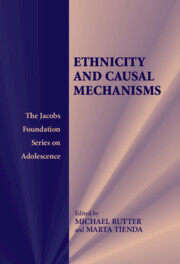Book contents
- Frontmatter
- Contents
- List of Contributors
- Foreword
- Preface
- 1 Natural Experiments, Causal Influences, and Policy Development
- 2 Growing Up Ethnic in the United Kingdom and the United States: Comparative Contexts for Youth Development
- 3 The Multiple Facets of Ethnicity
- 4 Educational Attainments: Ethnic Differences in the United Kingdom
- 5 Race and Ethnic Inequality in Educational Attainment in the United States
- 6 Racial and Ethnic Disparities in Crime and Delinquency in the United States
- 7 Explaining Ethnic Variations in Crime and Antisocial Behavior in the United Kingdom
- 8 Cultural Differences in the Effects of Physical Punishment
- 9 Ethnicity and Mental Health: The Example of Schizophrenia in the African-Caribbean Population in Europe
- 10 Ethnic Variations in Youth Suicide
- 11 Ethnicity and Intergenerational Identities and Adaptations in Britain: The Socio-Political Context
- 12 Assimilation, Dissimilation, and Ethnic Identities: The Experience of Children of Immigrants in the United States
- 13 Deciphering Ethnicity: Reflections on Research Opportunities
- Author Index
- Subject Index
3 - The Multiple Facets of Ethnicity
Published online by Cambridge University Press: 05 July 2014
- Frontmatter
- Contents
- List of Contributors
- Foreword
- Preface
- 1 Natural Experiments, Causal Influences, and Policy Development
- 2 Growing Up Ethnic in the United Kingdom and the United States: Comparative Contexts for Youth Development
- 3 The Multiple Facets of Ethnicity
- 4 Educational Attainments: Ethnic Differences in the United Kingdom
- 5 Race and Ethnic Inequality in Educational Attainment in the United States
- 6 Racial and Ethnic Disparities in Crime and Delinquency in the United States
- 7 Explaining Ethnic Variations in Crime and Antisocial Behavior in the United Kingdom
- 8 Cultural Differences in the Effects of Physical Punishment
- 9 Ethnicity and Mental Health: The Example of Schizophrenia in the African-Caribbean Population in Europe
- 10 Ethnic Variations in Youth Suicide
- 11 Ethnicity and Intergenerational Identities and Adaptations in Britain: The Socio-Political Context
- 12 Assimilation, Dissimilation, and Ethnic Identities: The Experience of Children of Immigrants in the United States
- 13 Deciphering Ethnicity: Reflections on Research Opportunities
- Author Index
- Subject Index
Summary
Dictionary definitions of ethnicity clearly bring out the complexity of the concept. Thus, the fifth edition of the Shorter Oxford English Dictionary (OED 2002) notes that it refers to population groups “sharing a distinctive cultural and historical tradition, often associated with race, nationality, or religion, by which the group identifies itself and others recognize it.” Ethnic minority is defined in terms of an “ethnic group differing physically or culturally from the rest of the community.” Constituting part (but only one part) of the concept of ethnicity, race is defined rather differently in terms of “a tribe, nation or people, regarded as of common stock” – with the key feature being biological descent from a common ancestor. A racial group is, then, an ethnic group whose members are believed, by others if not by themselves, to be physiologically distinctive (Alba, 1992). Biologically, according to the definition, race means a genetically or morphologically distinct species or subspecies.
Obviously, these multiple facets complicate the conceptualization of ethnicity. Does it mean a cultural, religious, or national group; or rather does it refer to a genetically distinct subspecies of humankind with physical characteristics that make it recognizable? When these different facets pull in different directions, which should be given preference? And, who should decide how to weight and prioritize the multiple facets of ethnicity? Clearly, there is no single unambiguously “correct” answer to those questions; much depends on the purposes to which the concept is applied.
- Type
- Chapter
- Information
- Ethnicity and Causal Mechanisms , pp. 50 - 79Publisher: Cambridge University PressPrint publication year: 2005
- 7
- Cited by



